2016 NISSAN TITAN coolant temperature
[x] Cancel search: coolant temperaturePage 369 of 636
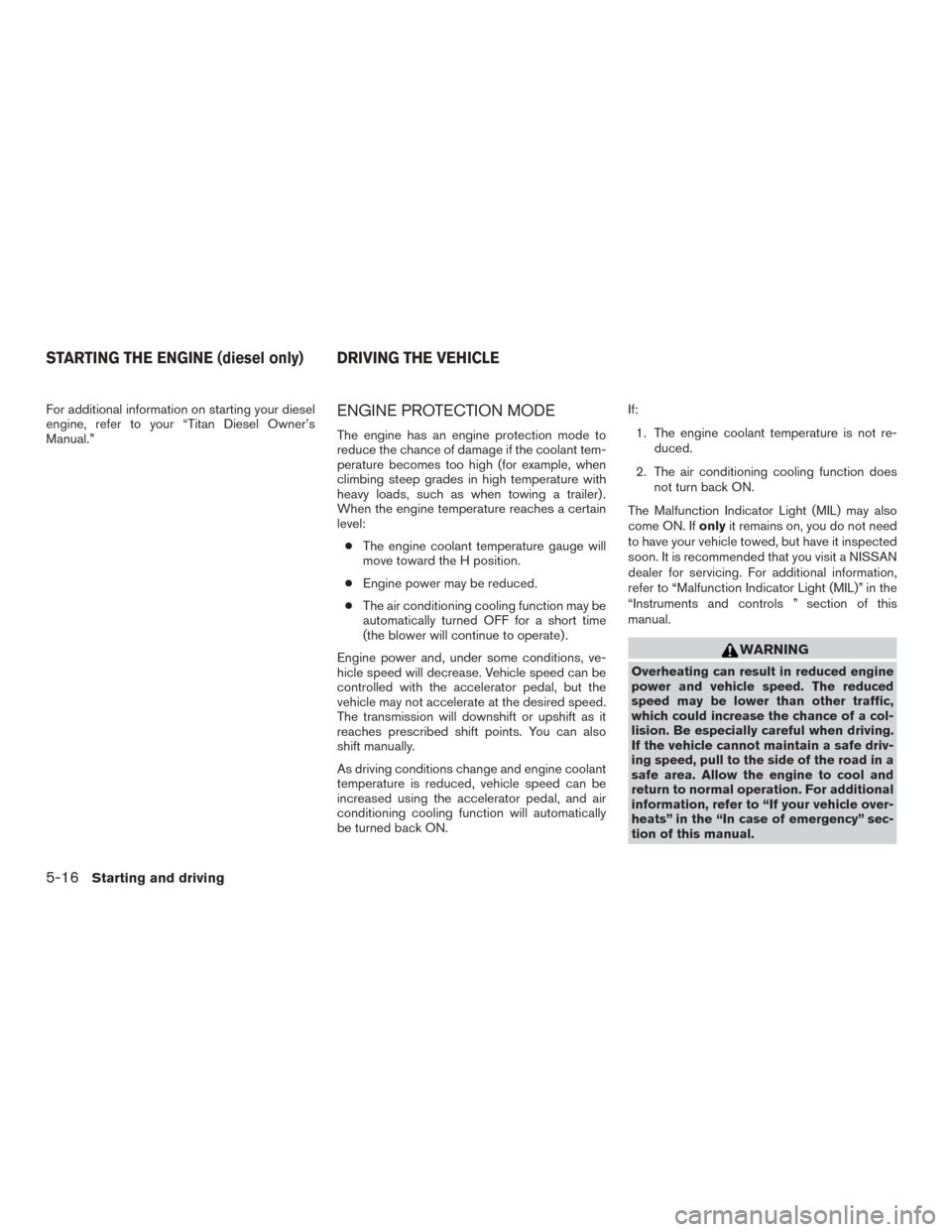
For additional information on starting your diesel
engine, refer to your “Titan Diesel Owner’s
Manual.”ENGINE PROTECTION MODE
The engine has an engine protection mode to
reduce the chance of damage if the coolant tem-
perature becomes too high (for example, when
climbing steep grades in high temperature with
heavy loads, such as when towing a trailer) .
When the engine temperature reaches a certain
level:● The engine coolant temperature gauge will
move toward the H position.
● Engine power may be reduced.
● The air conditioning cooling function may be
automatically turned OFF for a short time
(the blower will continue to operate) .
Engine power and, under some conditions, ve-
hicle speed will decrease. Vehicle speed can be
controlled with the accelerator pedal, but the
vehicle may not accelerate at the desired speed.
The transmission will downshift or upshift as it
reaches prescribed shift points. You can also
shift manually.
As driving conditions change and engine coolant
temperature is reduced, vehicle speed can be
increased using the accelerator pedal, and air
conditioning cooling function will automatically
be turned back ON. If:
1. The engine coolant temperature is not re- duced.
2. The air conditioning cooling function does not turn back ON.
The Malfunction Indicator Light (MIL) may also
come ON. If onlyit remains on, you do not need
to have your vehicle towed, but have it inspected
soon. It is recommended that you visit a NISSAN
dealer for servicing. For additional information,
refer to “Malfunction Indicator Light (MIL)” in the
“Instruments and controls ” section of this
manual.
WARNING
Overheating can result in reduced engine
power and vehicle speed. The reduced
speed may be lower than other traffic,
which could increase the chance of a col-
lision. Be especially careful when driving.
If the vehicle cannot maintain a safe driv-
ing speed, pull to the side of the road in a
safe area. Allow the engine to cool and
return to normal operation. For additional
information, refer to “If your vehicle over-
heats” in the “In case of emergency” sec-
tion of this manual.
STARTING THE ENGINE (diesel only) DRIVING THE VEHICLE
5-16Starting and driving
Page 418 of 636
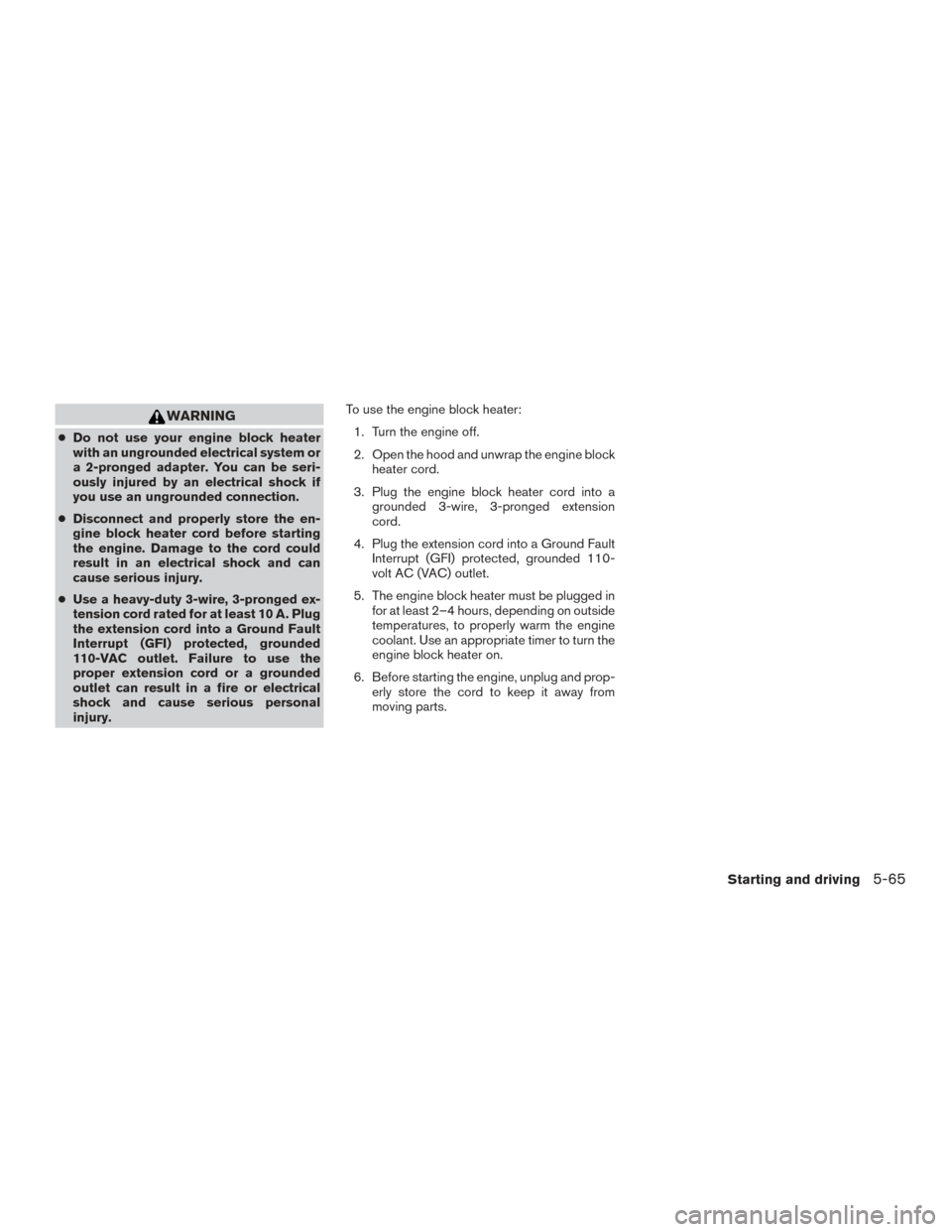
WARNING
●Do not use your engine block heater
with an ungrounded electrical system or
a 2-pronged adapter. You can be seri-
ously injured by an electrical shock if
you use an ungrounded connection.
● Disconnect and properly store the en-
gine block heater cord before starting
the engine. Damage to the cord could
result in an electrical shock and can
cause serious injury.
● Use a heavy-duty 3-wire, 3-pronged ex-
tension cord rated for at least 10 A. Plug
the extension cord into a Ground Fault
Interrupt (GFI) protected, grounded
110-VAC outlet. Failure to use the
proper extension cord or a grounded
outlet can result in a fire or electrical
shock and cause serious personal
injury. To use the engine block heater:
1. Turn the engine off.
2. Open the hood and unwrap the engine block heater cord.
3. Plug the engine block heater cord into a grounded 3-wire, 3-pronged extension
cord.
4. Plug the extension cord into a Ground Fault Interrupt (GFI) protected, grounded 110-
volt AC (VAC) outlet.
5. The engine block heater must be plugged in for at least 2–4 hours, depending on outside
temperatures, to properly warm the engine
coolant. Use an appropriate timer to turn the
engine block heater on.
6. Before starting the engine, unplug and prop- erly store the cord to keep it away from
moving parts.
Starting and driving5-65
Page 431 of 636
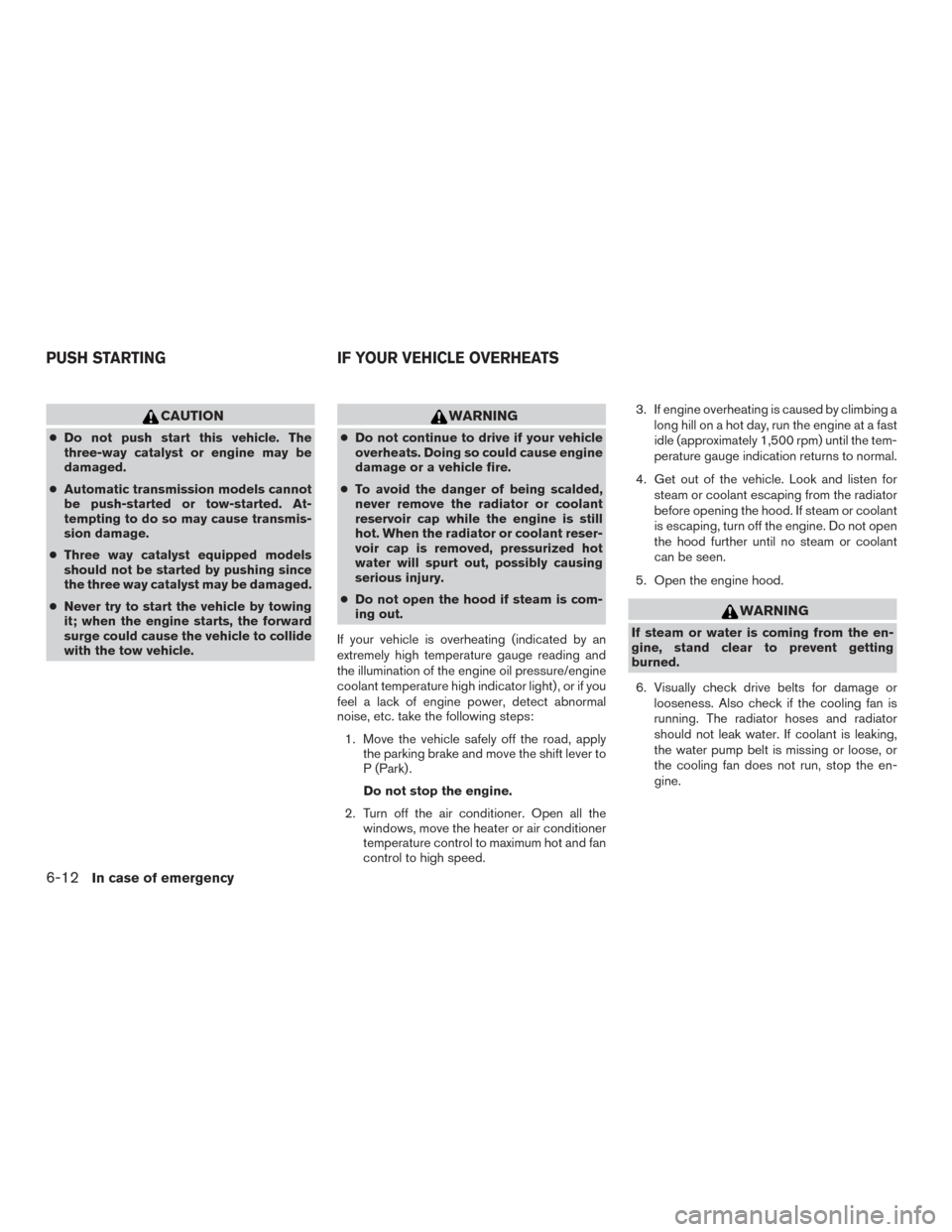
CAUTION
●Do not push start this vehicle. The
three-way catalyst or engine may be
damaged.
● Automatic transmission models cannot
be push-started or tow-started. At-
tempting to do so may cause transmis-
sion damage.
● Three way catalyst equipped models
should not be started by pushing since
the three way catalyst may be damaged.
● Never try to start the vehicle by towing
it; when the engine starts, the forward
surge could cause the vehicle to collide
with the tow vehicle.
WARNING
● Do not continue to drive if your vehicle
overheats. Doing so could cause engine
damage or a vehicle fire.
● To avoid the danger of being scalded,
never remove the radiator or coolant
reservoir cap while the engine is still
hot. When the radiator or coolant reser-
voir cap is removed, pressurized hot
water will spurt out, possibly causing
serious injury.
● Do not open the hood if steam is com-
ing out.
If your vehicle is overheating (indicated by an
extremely high temperature gauge reading and
the illumination of the engine oil pressure/engine
coolant temperature high indicator light) , or if you
feel a lack of engine power, detect abnormal
noise, etc. take the following steps: 1. Move the vehicle safely off the road, apply the parking brake and move the shift lever to
P (Park) .
Do not stop the engine.
2. Turn off the air conditioner. Open all the windows, move the heater or air conditioner
temperature control to maximum hot and fan
control to high speed. 3. If engine overheating is caused by climbing a
long hill on a hot day, run the engine at a fast
idle (approximately 1,500 rpm) until the tem-
perature gauge indication returns to normal.
4. Get out of the vehicle. Look and listen for steam or coolant escaping from the radiator
before opening the hood. If steam or coolant
is escaping, turn off the engine. Do not open
the hood further until no steam or coolant
can be seen.
5. Open the engine hood.
WARNING
If steam or water is coming from the en-
gine, stand clear to prevent getting
burned.
6. Visually check drive belts for damage or looseness. Also check if the cooling fan is
running. The radiator hoses and radiator
should not leak water. If coolant is leaking,
the water pump belt is missing or loose, or
the cooling fan does not run, stop the en-
gine.
PUSH STARTING IF YOUR VEHICLE OVERHEATS
6-12In case of emergency
Page 489 of 636

Steering wheelCheck for changes in the steer-
ing system, such as excessive freeplay, hard
steering or strange noises.
Warning lights and chimes Make sure all
warning lights and chimes are operating properly.
Windshield wiper and washer* Check that
the wipers and washer operate properly and that
the wipers do not streak.
Windshield defroster Check that the air
comes out of the defroster outlets properly and in
sufficient quantity when operating the heater or
air conditioner.
Under the hood and vehicle
The maintenance items listed here should be
checked periodically (for example, each time you
check the engine oil or refuel) .
Battery* (for seviceable batteries) Check the
fluid level in each cell. It should be between the
MAX and MIN lines. Vehicles operated in high
temperatures or under severe conditions require
frequent checks of the battery fluid level. NOTE:
Care should be taken to avoid situations
that can lead to potential battery discharge
and potential no-start conditions such as:
1. Installation or extended use of electronic accessories that consume battery power
when the engine is not running (Phone char-
gers, GPS, DVD players, etc.) .
2. Vehicle is not driven regularly and/or only driven short distances. In these cases, the
battery may need to be charged to maintain
battery health.
Brake fluid level* Make sure that the brake fluid
level is between the MIN and MAX lines on the
reservoir.
Engine coolant level* Check the coolant level
when the engine is cold.
Engine drive belts* Make sure the drive belts
are not frayed, worn, cracked or oily.
Engine oil level* Check the level after parking
the vehicle on a level surface with the engine off.
Wait more than 10 minutes for the oil to drain
back into the oil pan. Exhaust system
Visually inspect the exhaust
pipes, muffler and hangers for leaks, cracks, de-
terioration and damage. Tighten connections or
replace parts as necessary. For additional infor-
mation, refer to “Exhaust gas (carbon monoxide)”
in the “Starting and driving” section of this
manual.
Fluid leaks Check under the vehicle for fuel, oil,
water or other fluid leaks after the vehicle has
been parked for a while. Water dripping from the
air conditioner after use is normal. If you should
notice any leaks or if fuel fumes are evident,
check for the cause and have it corrected imme-
diately.
Power steering fluid level* and lines Check
the level when the fluid is cold, with the engine
off. Check the lines for proper attachment, leaks,
cracks, etc.
Radiator and hoses Check the front of the
radiator and clean off any dirt, insects, leaves,
etc., that may have accumulated. Make sure the
hoses have no cracks, deformation, rot or loose
connections.
9-4Maintenance and schedules
Page 555 of 636
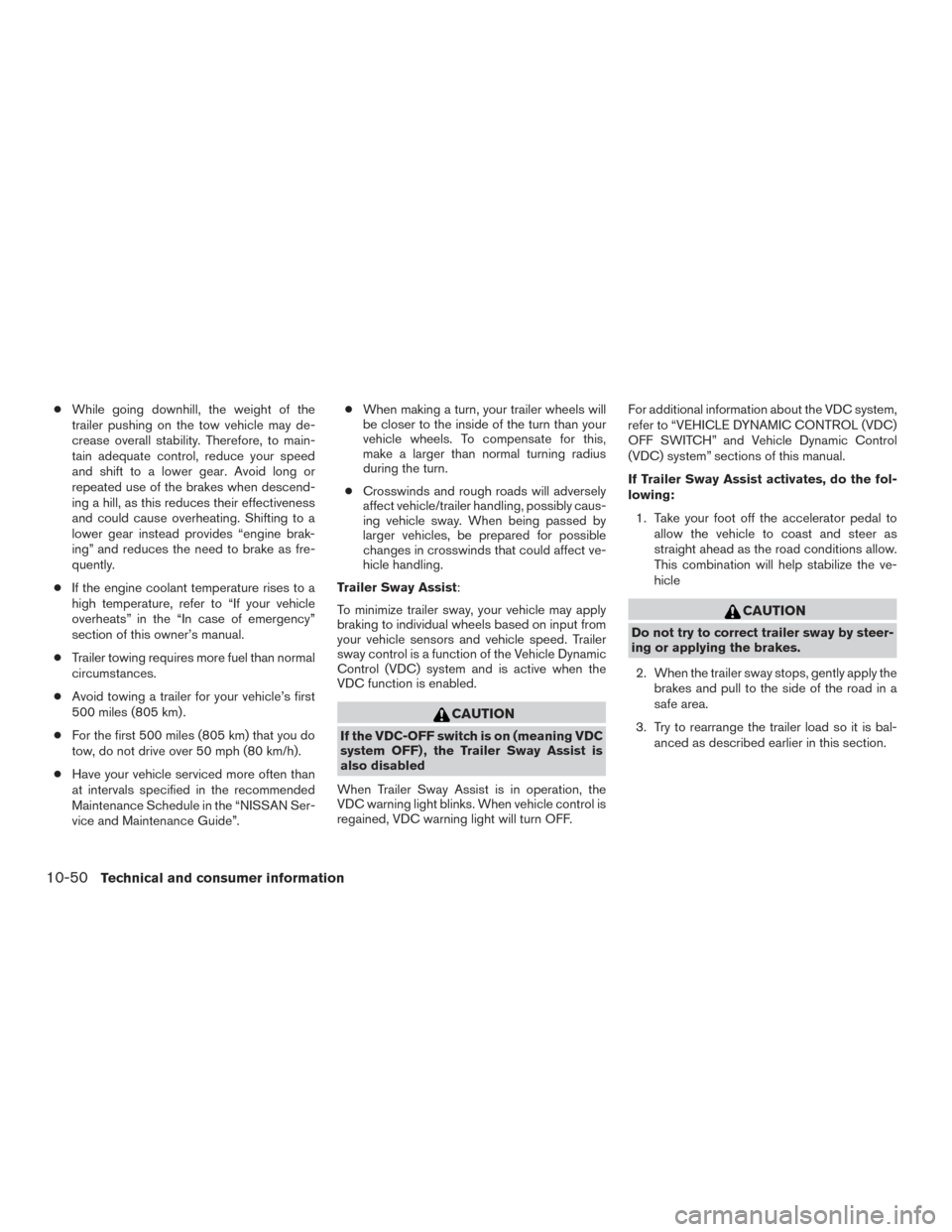
●While going downhill, the weight of the
trailer pushing on the tow vehicle may de-
crease overall stability. Therefore, to main-
tain adequate control, reduce your speed
and shift to a lower gear. Avoid long or
repeated use of the brakes when descend-
ing a hill, as this reduces their effectiveness
and could cause overheating. Shifting to a
lower gear instead provides “engine brak-
ing” and reduces the need to brake as fre-
quently.
● If the engine coolant temperature rises to a
high temperature, refer to “If your vehicle
overheats” in the “In case of emergency”
section of this owner’s manual.
● Trailer towing requires more fuel than normal
circumstances.
● Avoid towing a trailer for your vehicle’s first
500 miles (805 km) .
● For the first 500 miles (805 km) that you do
tow, do not drive over 50 mph (80 km/h).
● Have your vehicle serviced more often than
at intervals specified in the recommended
Maintenance Schedule in the “NISSAN Ser-
vice and Maintenance Guide”. ●
When making a turn, your trailer wheels will
be closer to the inside of the turn than your
vehicle wheels. To compensate for this,
make a larger than normal turning radius
during the turn.
● Crosswinds and rough roads will adversely
affect vehicle/trailer handling, possibly caus-
ing vehicle sway. When being passed by
larger vehicles, be prepared for possible
changes in crosswinds that could affect ve-
hicle handling.
Trailer Sway Assist:
To minimize trailer sway, your vehicle may apply
braking to individual wheels based on input from
your vehicle sensors and vehicle speed. Trailer
sway control is a function of the Vehicle Dynamic
Control (VDC) system and is active when the
VDC function is enabled.
CAUTION
If the VDC-OFF switch is on (meaning VDC
system OFF) , the Trailer Sway Assist is
also disabled
When Trailer Sway Assist is in operation, the
VDC warning light blinks. When vehicle control is
regained, VDC warning light will turn OFF. For additional information about the VDC system,
refer to “VEHICLE DYNAMIC CONTROL (VDC)
OFF SWITCH” and Vehicle Dynamic Control
(VDC) system” sections of this manual.
If Trailer Sway Assist activates, do the fol-
lowing:
1. Take your foot off the accelerator pedal to allow the vehicle to coast and steer as
straight ahead as the road conditions allow.
This combination will help stabilize the ve-
hicle
CAUTION
Do not try to correct trailer sway by steer-
ing or applying the brakes.
2. When the trailer sway stops, gently apply the brakes and pull to the side of the road in a
safe area.
3. Try to rearrange the trailer load so it is bal- anced as described earlier in this section.
10-50Technical and consumer information
Page 563 of 636
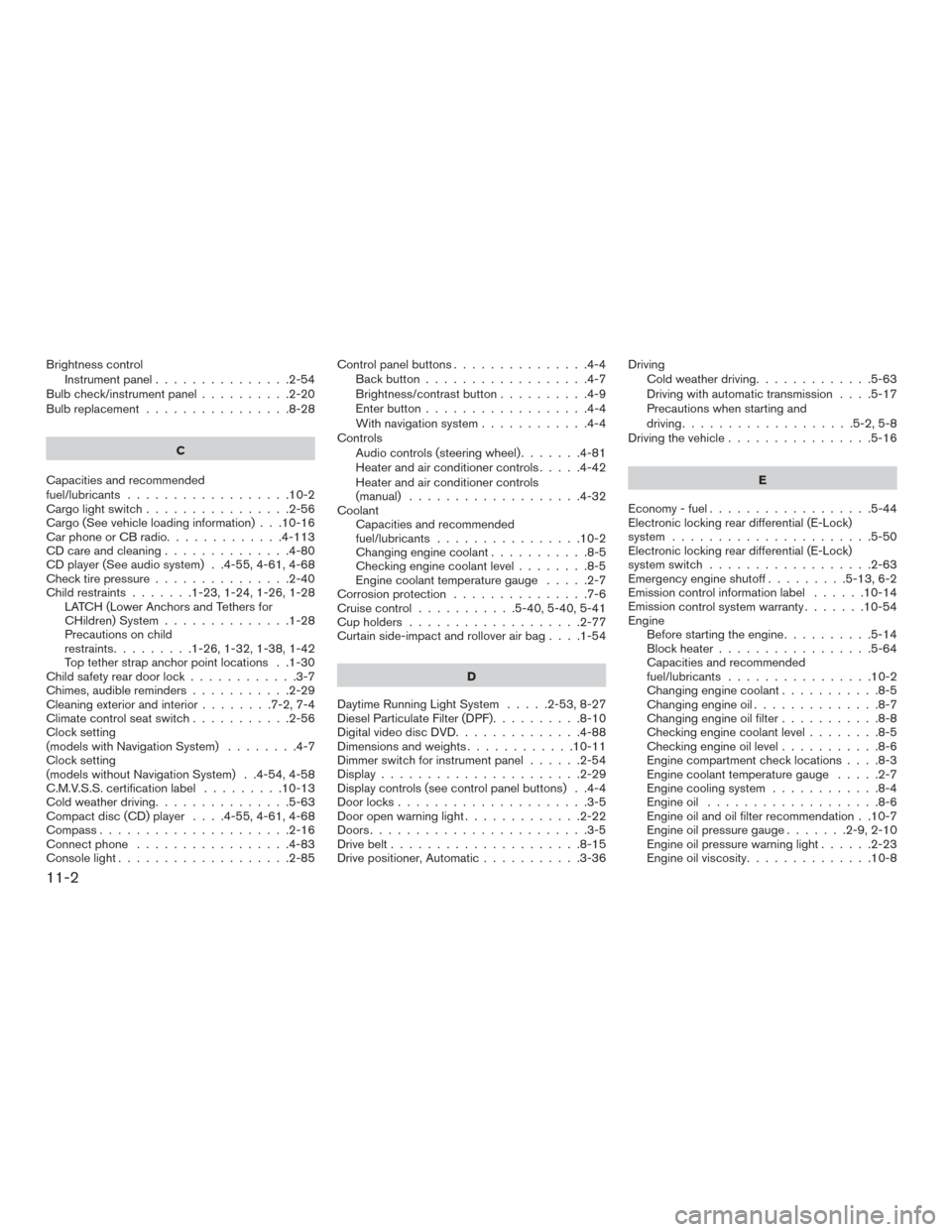
Brightness controlInstrument panel ...............2-54
Bulb check/instrument panel ..........2-20
Bulb replacement ................8-28
C
Capacities and recommended
fuel/lubricants ..................10-2
Cargolightswitch................2-56
Cargo (See vehicle loading information) . . .10-16
Car phone or CB radio .............4-113
CD care and cleaning ..............4-80
CD player (See audio system) . .4-55, 4-61, 4-68
Check tire pressure ...............2-40
Child restraints .......1-23,1-24,1-26,1-28
LATCH (Lower Anchors and Tethers for
CHildren) System ..............1-28
Precautions on child
restraints.........1-26,1-32,1-38,1-42
Top tether strap anchor point locations . .1-30
Child safety rear door lock ............3-7
Chimes, audible reminders ...........2-29
Cleaningexteriorandinterior........7-2,7-4
Climatecontrolseatswitch...........2-56
Clock setting
(models with Navigation System) ........4-7
Clock setting
(models without Navigation System) . .4-54, 4-58
C.M.V.S.S. certification label .........10-13
Cold weather driving ...............5-63
Compact disc (CD) player ....4-55,4-61,4-68
Compass .....................2-16
Connect phone .................4-83
Consolelight...................2-85 Control panel buttons
...............4-4
Back button ..................4-7
Brightness/contrast button ..........4-9
Enterbutton..................4-4
With navigation system ............4-4
Controls Audio controls (steering wheel) .......4-81
Heater and air conditioner controls .....4-42
Heater and air conditioner controls
(manual) ...................4-32
Coolant Capacities and recommended
fuel/lubricants ................10-2
Changingenginecoolant...........8-5
Checking engine coolant level ........8-5
Engine coolant temperature gauge .....2-7
Corrosion protection ...............7-6
Cruisecontrol ...........5-40,5-40,5-41
Cupholders...................2-77
Curtainside-impactandrolloverairbag....1-54
D
Daytime Running Light System .....2-53,8-27
Diesel Particulate Filter (DPF) ..........8-10
Digital video disc DVD ..............4-88
Dimensionsandweights............10-11
Dimmer switch for instrument panel ......2-54
Display......................2-29
Display controls (see control panel buttons) . .4-4
Door locks .....................3-5
Door open warning light .............2-22
Doors ........................3-5
Drive belt .....................8-15
Drive positioner, Automatic ...........3-36Driving
Cold weather driving .............5-63
Driving with automatic transmission ....5-17
Precautions when starting and
driving ...................5-2,5-8
Driving the vehicle ................5-16
E
Economy-fuel..................5-44
Electronic locking rear differential (E-Lock)
system ......................5-50
Electronic locking rear differential (E-Lock)
system switch ..................2-63
Emergency engine shutoff .........5-13,6-2
Emission control information label ......10-14
Emission
control system warranty .......10-54
Engine Before starting the engine ..........5-14
Blockheater.................5-64
Capacities and recommended
fuel/lubricants ................10-2
Changing engine coolant ...........8-5
Changingengineoil..............8-7
Changing engine oil filter ...........8-8
Checking engine coolant level ........8-5
Checking engine oil level ...........8-6
Engine compartment check locations ....8-3
Engine coolant temperature gauge .....2-7
Engine cooling system ............8-4
Engineoil ...................8-6
Engine oil and oil filter recommendation . .10-7
Engineoilpressuregauge.......2-9,2-10
Engine oil pressure warning light ......2-23
Engine oil viscosity ..............10-8
11-2
Page 564 of 636
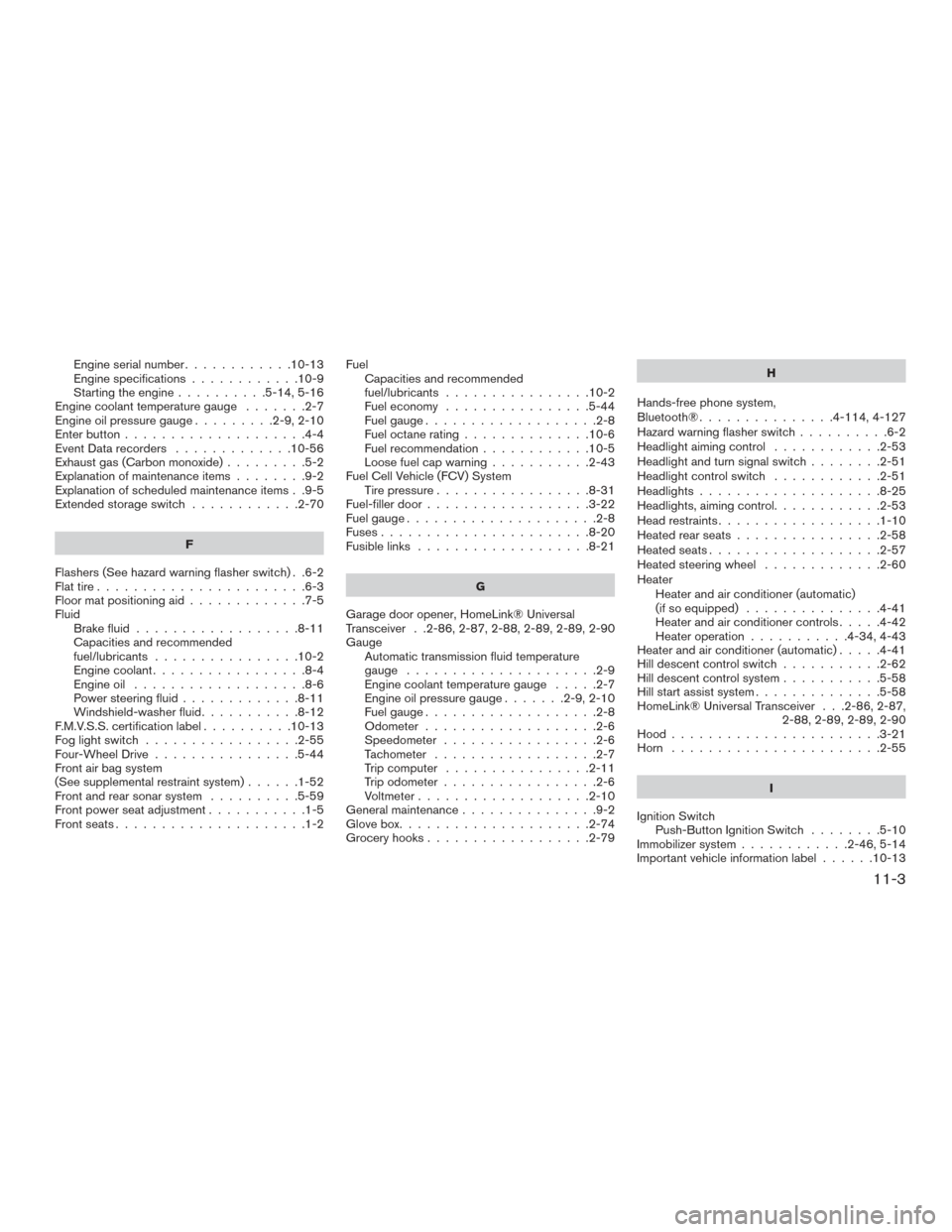
Engine serial number............10-13
Engine specifications ............10-9
Starting the engine ..........5-14,5-16
Engine coolant temperature gauge .......2-7
Engineoilpressuregauge.........2-9,2-10
Enterbutton....................4-4
Event Data recorders .............10-56
Exhaust gas (Carbon monoxide) .........5-2
Explanation of maintenance items ........9-2
Explanation of scheduled maintenance items . .9-5
Extendedstorageswitch ............2-70
F
Flashers (See hazard warning flasher switch) . .6-2
Flat tire .......................6-3
Floor mat positioning aid .............7-5
Fluid Brake fluid ..................8-11
Capacities and recommended
fuel/lubricants ................10-2
Engine coolant .................8-4
Engine oil ...................8-6
Power steering fluid .............8-11
Windshield-washerfluid...........8-12
F.M.V.S.S. certification label ..........10-13
Foglightswitch .................2-55
Four-Wheel Drive ................5-44
Front air bag system
(See supplemental restraint system) ......1-52
Front and rear sonar system ..........5-59
Front power seat adjustment ...........1-5
Frontseats.....................1-2 Fuel
Capacities and recommended
fuel/lubricants ................10-2
Fuel economy ................5-44
Fuel gauge ...................2-8
Fuel octane rating ..............10-6
Fuel recommendation ............10-5
Loose fuel cap warning ...........2-43
Fuel Cell Vehicle (FCV) System Tirepressure.................8-31
Fuel-filler door ..................3-22
Fuelgauge.....................2-8
Fuses.......................8-20
Fusiblelinks ...................8-21
G
Garage door opener, HomeLink® Universal
Transceiver . .2-86, 2-87, 2-88, 2-89, 2-89, 2-90
Gauge Automatic transmission fluid temperature
gauge .....................2-9
Engine coolant temperature gauge .....2-7
Engine oil pressure gauge .......2-9,2-10
Fuel gauge ...................2-8
Odometer ...................2-6
Speedometer .................2-6
Tachometer ..................2-7
Trip computer ................2-11
Trip odometer .................2-6
Voltmeter...................2-10
General maintenance ...............9-2
Glovebox.....................2-74
Grocery hooks ..................2-79 H
Hands-free phone system,
Bluetooth®...............4-114, 4-127
Hazard warning flasher switch ..........6-2
Headlightaimingcontrol ............2-53
Headlightandturnsignalswitch........2-51
Headlightcontrolswitch ............2-51
Headlights....................8-25
Headlights, aiming control ............2-53
Head restraints ..................1-10
Heated rear seats ................2-58
Heated seats ...................2-57
Heated steering wheel .............2-60
Heater Heater
and air conditioner (automatic)
(if so equipped) ...............4-41
Heater and air conditioner controls .....4-42
Heater operation ...........4-34,4-43
Heater and air conditioner (automatic) .....4-41
Hill descent control switch ...........2-62
Hill descent control system ...........5-58
Hill start assist system ..............5-58
HomeLink® Universal Transceiver . . .2-86, 2-87, 2-88, 2-89, 2-89, 2-90
Hood.......................3-21
Horn .......................2-55
I
Ignition Switch Push-Button Ignition Switch ........5-10
Immobilizer system ............2-46,5-14
Important vehicle information label ......10-13
11-3
Page 568 of 636
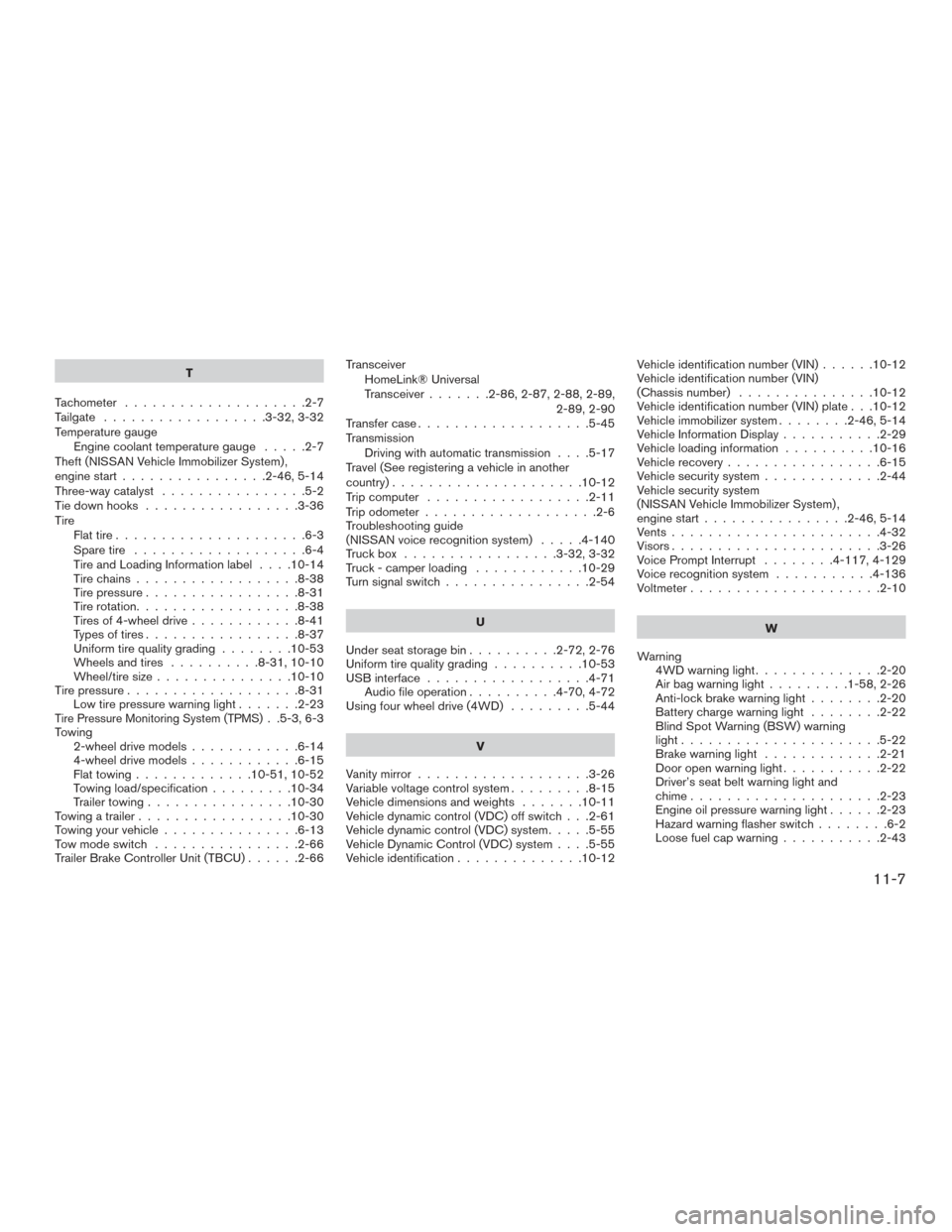
T
Tachometer ....................2-7
Tailgate ..................3-32,3-32
Temperature gauge Engine coolant temperature gauge .....2-7
Theft (NISSAN Vehicle Immobilizer System) ,
engine start ................2-46,5-14
Three-way catalyst ................5-2
Tie down hooks .................3-36
Tire Flat tire .....................6-3
Spare tire ...................6-4
TireandLoadingInformationlabel ....10-14
Tire chains ..................8-38
Tirepressure.................8-31
Tire rotation..................8-38
Tires of 4-wheel drive ............8-41
Types of tires .................8-37
Uniform tire quality grading ........10-53
Wheels and tires ..........8-31,10-10
Wheel/tire size ...............10-10
Tirepressure...................8-31 Low tire pressure warning light .......2-23
Tire Pressure Monitoring System (TPMS). .5-3, 6-3
Towing 2-wheel drive models ............6-14
4-wheel drive models ............6-15
Flattowing.............10-51,10-52
Towing load/specification .........10-34
Trailer towing ................10-30
Towing a trailer .................10-30
Towingyourvehicle...............6-13
Tow mode switch ................2-66
Trailer Brake Controller Unit (TBCU) ......2-66Transceiver
HomeLink® Universal
Transceiver .......2-86,2-87,2-88,2-89,
2-89, 2-90
Transfer case ...................5-45
Transmission Driving with automatic transmission ....5-17
Travel (See registering a vehicle in another
country) .....................10-12
Trip computer ..................2-11
Trip odometer ...................2-6
Troubleshooting guide
(NISSAN voice recognition system) .....4-140
Truckbox .................3-32,3-32
Truck - camper loading ............10-29
Turn signal switch ................2-54
U
Under seat storage bin ..........2-72,2-76
Uniform tire quality grading ..........10-53
USB interface ..................4-71
Audio file operation ..........4-70,4-72
Using four wheel drive (4WD) .........5-44
V
Vanity mirror ...................3-26
Variable voltage control system .........8-15
Vehicle dimensions and weights .......10-11
Vehicle dynamic control (VDC) off switch . . .2-61
Vehicle dynamic control (VDC) system .....5-55
Vehicle Dynamic Control (VDC) system ....5-55
Vehicle identification ..............10-12 Vehicle identification number (VIN)
......10-12
Vehicle identification number (VIN)
(Chassis number) ...............10-12
Vehicle identification number (VIN) plate . . .10-12
Vehicle immobilizer system ........2-46,5-14
Vehicle Information Display ...........2-29
Vehicle loading information ..........10-16
Vehicle recovery .................6-15
Vehicle security system .............2-44
Vehicle security system
(NISSAN Vehicle Immobilizer System) ,
enginestart................2-46,5-14
Vents.......................4-32
Visors.......................3-26
Voice Prompt Interrupt ........4-117, 4-129
Voice recognition system ...........4-136
Voltmeter.....................2-10
W
Warning 4WD warning light ..............2-20
Airbagwarninglight.........1-58,2-26
Anti-lock brake warning light ........2-20
Battery charge warning light ........2-22
Blind Spot Warning (BSW) warning
light......................5-22
Brake warning light .............2-21
Door open warning light ...........2-22
Driver’s seat belt warning light and
chime.....................2-23
Engine oil pressure warning light ......2-23
Hazard warning flasher switch ........6-2
Loose fuel cap warning ...........2-43
11-7